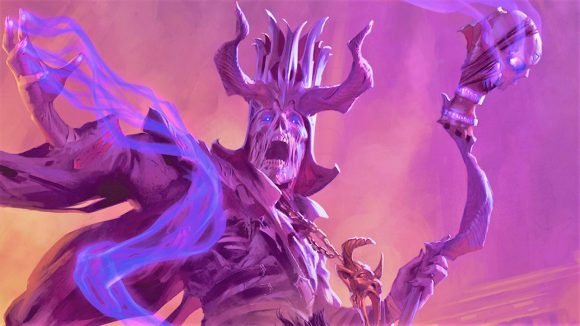The Lich of D&D lore is a Wizard consumed by selfishness who transforms into an undead skeletal monster, their flesh withered and their soul captured in a phylactery that keeps them in a state of undeath. But why should one class have all the fun? Thanks to a dedicated DnD homebrewer, Lichdom is no longer just for Wizards.
Stephen Bandstra, writer and co-founder of TTRPG blog Dump Stat Adventures, recently completed a quest to create a homebrew that turns all the TTRPG’s classes into undead Liches. He shared his first Lich-ifying content on his blog on May 31, where the Bard, Warlock, Druid, and Sorcerer all received an evil undead counterpart. These classes were joined by the Artificer, Barbarian, Monk, Ranger, Fighter, and Rogue on July 12.
The keen-eyed among you will spot a few classes missing from this list, but that’s by design. The Wizard is obviously accounted for, and Clerics and Paladins already have similar undead forms – the Mummy for Clerics and the Death Knight for Paladins.
“The Liches have been a work-in-progress for several years as a basic idea – and as various stat blocks – but it wasn’t until a few months ago I created true stat blocks for them”, Bandstra tells Wargamer. “I’ve seen a lot of conversations in the past about what Liches for different classes might look like”, he adds. “We did a Deep Dive on the history of the Lich on our website, which gave me a very firm idea about the Lich and what goes into being a Lich. Taking that knowledge, I then applied it to the various classes.”
These new Liches go by many names, but Bandstra has gone beyond just christening the creatures. Each monster has a detailed background, lair description, and stat block.

The first wave (Bard, Warlock, Druid, and Sorcerer) all have a challenge rating (CR) of 21, while the remaining Lich-alikes are CR 17. For comparison, your typical Lich has a CR of 21, and a Death Knight is CR 17 – the Clerics get a rough deal, with the Mummy Lord stuck at CR 15.
From here, each creature gets slightly more unique. The Bard becomes the Adreafan, whose vain craving for an eternal spotlight turns them into something of an energy vampire; the Druid (or Druadh) fuse with fungi and use spores to feed on the living; Warlocks transform into Cynes by consuming some (or all) of their former patron; and Hollows are made from Sorcerers who undergo the same hollowing ritual as mighty dragons.
Bards aren’t the only energy vampires in the gang, either – Monks become Aethen, who sustain themselves by draining ki. Biogic Artificers modify their bodies beyond recognition, and their souls are split between their most significant magic items. Undead Barbarians become Odr who seek eternal battle, while a Reaniment Fighter stores their soul in a single legendary shield, weapon, or piece of armour – which it uses to possess any who carry it after the Reaniment ‘dies’.
Finally, there’s the Shade (Rogue) and Wiljag (Ranger), who become the most extreme version of their living selves – Shades hide from death by replacing their life essence with energy from the Shadow Plane, while Wiljags are kept (un)alive by an eternal drive to hunt their chosen prey.

Bandstra says he’s playtested most of the Liches, though they’ve not all had full testing treatment yet. “Sadly the Wiljag (Ranger) and Druadh (Druid) did not get a chance beyond theorycrafting and running mock simulations, checking numbers, etc”, he says, “but I needed them for a full set.”
Bandstra hasn’t decided if any further Lich homebrews are coming. “I’ve run out of classes – unless I want to redo the Mummy, Death Knight, and Lich – but third edition had a ton of classes which could be quite fun (or horrible, it’s definitely one of those two).”
You can find the full stat blocks for the wave one Liches on this Dump Stat Adventures blog page, and the remaining homebrew Liches are on this separate blog page. You can also check out our DnD homebrew guide for tips on creating your own content.
